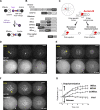Tension promotes kinetochore-microtubule release by Aurora B kinase
- PMID: 33904910
- PMCID: PMC8082439
- DOI: 10.1083/jcb.202007030
Tension promotes kinetochore-microtubule release by Aurora B kinase
Abstract
To ensure accurate chromosome segregation, interactions between kinetochores and microtubules are regulated by a combination of mechanics and biochemistry. Tension provides a signal to discriminate attachment errors from bi-oriented kinetochores with sisters correctly attached to opposite spindle poles. Biochemically, Aurora B kinase phosphorylates kinetochores to destabilize interactions with microtubules. To link mechanics and biochemistry, current models regard tension as an input signal to locally regulate Aurora B activity. Here, we show that the outcome of kinetochore phosphorylation depends on tension. Using optogenetics to manipulate Aurora B at individual kinetochores, we find that kinase activity promotes microtubule release when tension is high. Conversely, when tension is low, Aurora B activity promotes depolymerization of kinetochore-microtubules while maintaining attachment. Thus, phosphorylation converts a catch-bond, in which tension stabilizes attachments, to a slip-bond, which releases microtubules under tension. We propose that tension is a signal inducing distinct error-correction pathways, with release or depolymerization being advantageous for typical errors characterized by high or low tension, respectively.
© 2021 Chen et al.
Figures







Similar articles
-
Tension can directly suppress Aurora B kinase-triggered release of kinetochore-microtubule attachments.Nat Commun. 2022 Apr 20;13(1):2152. doi: 10.1038/s41467-022-29542-8. Nat Commun. 2022. PMID: 35443757 Free PMC article.
-
Swap and stop - Kinetochores play error correction with microtubules: Mechanisms of kinetochore-microtubule error correction: Mechanisms of kinetochore-microtubule error correction.Bioessays. 2022 May;44(5):e2100246. doi: 10.1002/bies.202100246. Epub 2022 Mar 8. Bioessays. 2022. PMID: 35261042 Free PMC article.
-
A tension-independent mechanism reduces Aurora B-mediated phosphorylation upon microtubule capture by CENP-E at the kinetochore.Cell Cycle. 2019 Jun;18(12):1349-1363. doi: 10.1080/15384101.2019.1617615. Epub 2019 May 23. Cell Cycle. 2019. PMID: 31122175 Free PMC article.
-
Regulation of kinetochore-microtubule attachments by Aurora B kinase.Biochem Soc Trans. 2009 Oct;37(Pt 5):976-80. doi: 10.1042/BST0370976. Biochem Soc Trans. 2009. PMID: 19754435 Review.
-
Correcting aberrant kinetochore microtubule attachments: a hidden regulation of Aurora B on microtubules.Curr Opin Cell Biol. 2019 Jun;58:34-41. doi: 10.1016/j.ceb.2018.12.007. Epub 2019 Jan 23. Curr Opin Cell Biol. 2019. PMID: 30684807 Free PMC article. Review.
Cited by
-
Chromosome size-dependent polar ejection force impairs mammalian mitotic error correction.bioRxiv [Preprint]. 2023 Oct 18:2023.10.16.562637. doi: 10.1101/2023.10.16.562637. bioRxiv. 2023. Update in: J Cell Biol. 2024 Aug 5;223(8):e202310010. doi: 10.1083/jcb.202310010. PMID: 37905080 Free PMC article. Updated. Preprint.
-
Polar Chromosomes-Challenges of a Risky Path.Cells. 2022 May 3;11(9):1531. doi: 10.3390/cells11091531. Cells. 2022. PMID: 35563837 Free PMC article. Review.
-
Attenuated Chromosome Oscillation as a Cause of Chromosomal Instability in Cancer Cells.Cancers (Basel). 2021 Sep 9;13(18):4531. doi: 10.3390/cancers13184531. Cancers (Basel). 2021. PMID: 34572757 Free PMC article. Review.
-
Confinement in fibrous environments positions and orients mitotic spindles.bioRxiv [Preprint]. 2024 Apr 15:2024.04.12.589246. doi: 10.1101/2024.04.12.589246. bioRxiv. 2024. Update in: PNAS Nexus. 2025 Jun 16;4(7):pgaf201. doi: 10.1093/pnasnexus/pgaf201. PMID: 38659898 Free PMC article. Updated. Preprint.
-
MCAK/Kif2C centromeric activity level tunes K-fiber stability.bioRxiv [Preprint]. 2025 Feb 17:2025.02.16.638494. doi: 10.1101/2025.02.16.638494. bioRxiv. 2025. PMID: 40027728 Free PMC article. Preprint.
References
Publication types
MeSH terms
Substances
Grants and funding
LinkOut - more resources
Full Text Sources
Other Literature Sources
Research Materials
Miscellaneous

